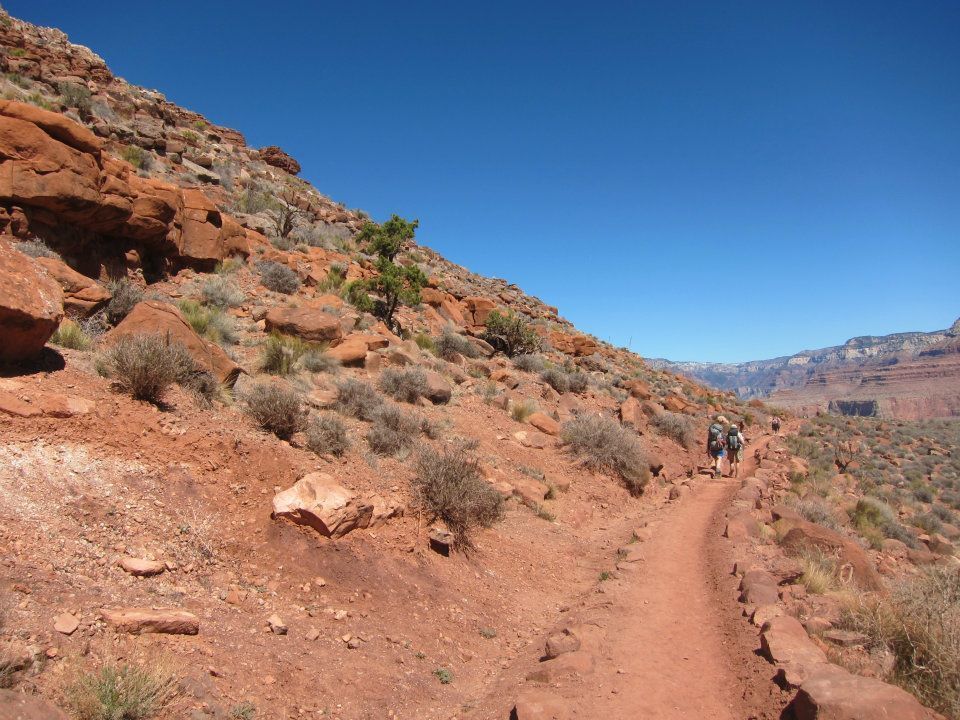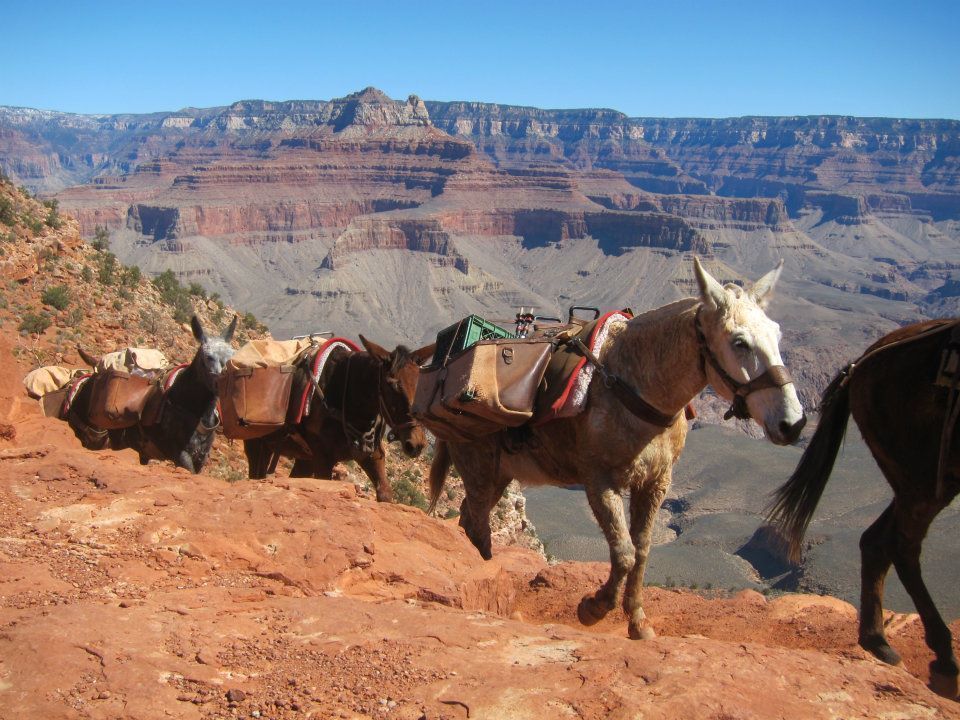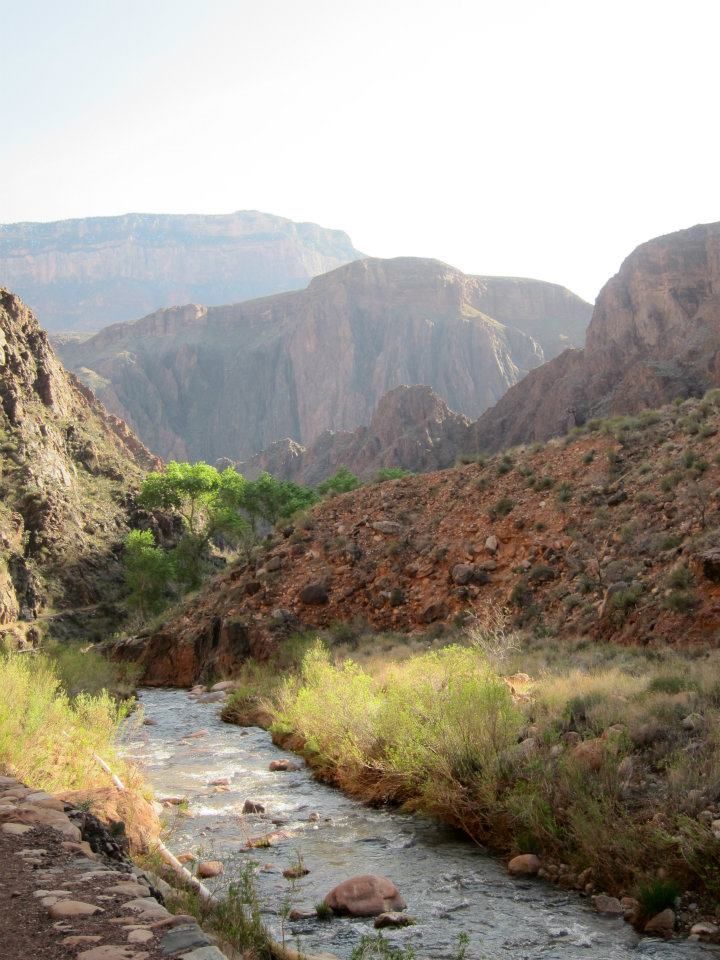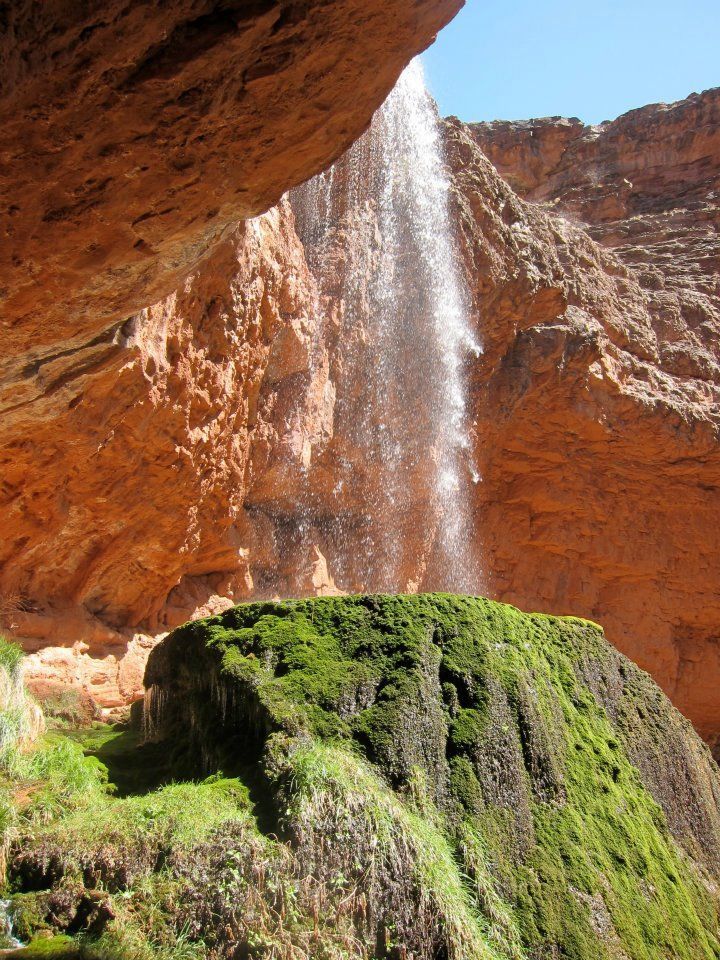
Finding standing water in Arizona is about as common as finding a hundred dollar bill on a city sidewalk—if it does fortuitously appear, it disappears almost instantly. Driving north on I-17, from Phoenix to the Grand Canyon, signposts mark where water should be. But the Agua Fria River is merely a dry rockbed, and the New River is apparently so new that it hasn’t appeared yet. These are intermittent streams. They only flow when enough rain falls, and rain hasn’t fallen recently. The already-arid Southwest has been in a state of drought for over ten years.
And yet, despite its scant rainfall, the Grand Canyon supports an astonishing array of plant and animal life, from large mammals, like elk and mule deer to thousands of species of insects. It manages this feat by hiding water in the most unlikely and fragile of places, creating small pockets of biodiversity in an otherwise harsh landscape.
The Canyon
The first time I visited the Grand Canyon and saw the Colorado River snaking through the rocks far below, I promised myself that someday I would reach the bottom. As a nine-year-old, the thought of dipping my toes in the water at the bottom of this massive chasm seemed as impressive as summiting Mount Everest.
Twelve years later, I stand on the canyon rim on a chilly March morning, mentally preparing to hike down. All I can think about is whether I’ll make it out again. My pack, which felt comfortable earlier that morning, is now cutting into my shoulders. I’m regretting stuffing in a second paperback novel. In addition to a sleeping bag and a week’s worth of clothes, I’m carrying three full liters of water because there’s nowhere to restock along the South Kaibab Trail.
There’s no water along the trail not by any fault of the Park Service, but because the Grand Canyon is a semi-arid desert. You wouldn’t necessarily guess it from standing on the rim, where pinyon pines and junipers grow in crooked forests out of the rocks. However, the South Rim receives only sixteen inches of precipitation a year, mostly in the form of winter snowfall, and Phantom Ranch receives less than ten inches. When rain does fall, it often comes in torrents; unable to seep into the ground quickly enough, most is lost as runoff.

Descending into the canyon, the absence of water becomes more apparent. Vegetation becomes smaller and scrubbier. Prickly pear cactuses appear, ready to sink their spines into my legs with any misstep.
Hours later, my legs are coated with dust and I’m sweating through my shirt. My feet are swollen and sore. My big toe is bruised from repeatedly hitting the toe box of my boot. And then something miraculous happens: I reach the Colorado River.
The landscape changes instantly. The prickly pears are now nestled next to more friendly horsetails and shaded by willow trees. To celebrate my successful descent, I pull off my sweaty hiking boots and cautiously wade into the rushing river. Within seconds, my feet are purple and cramping in pain. I run to dry my toes on the warm sand. I feel better when, moments later, a young woman wearing a full-body neoprene Spiderman suit plunges fearlessly into the river and pops up muttering expletives. Even superheroes find the Colorado too cold.
The Colorado River is so big that it’s tempting to assume it’s the most important water source in the park. Its integral role in carving the canyon aside, it is undeniably an important habitat. A 1976 survey of the riparian habitat along its banks identified 807 species of plants, 178 species of birds, and over 12,000 species of insects along the 277-mile stretch that runs through the Grand Canyon. However, the Colorado is just one water source that flows at the bottom of this mile-deep gorge. Though it is large, its waters are inaccessible or unsuitable for many species. And so canyon flora and fauna, as well as human visitors to the park, must rely on springs and seeps in the canyon’s walls in order to survive.
Aquifers, underground water reservoirs, offer an important counterpoint to the boom and bust behavior of surface water in the canyon. They form when layers of less permeable rock abut a section of more porous rock whose open spaces catch and store water that seeps into and travels through the ground. The multilayered Grand Canyon sits on top of two: the Redwall-Muav aquifer, a layer of limestone 3,000 feet below the earth’s surface, and the Coconino aquifer, a shallow sandstone formation. If the flow of water through the underground aquifer crosses a less-porous boundary, pressure pushes the water to the surface to form a spring. These springs dot the canyon walls and create tiny but critical habitats for plants and animals alike.
Seeps and springs are rare on the dry South Rim walls. Far from rendering them irrelevant, though, their scarcity makes them all the more critical. According to Larry Stevens, Curator of Ecology and Conservation at the Museum of Northern Arizona and an expert on Grand Canyon ecology, springs make up just a thousandth of a percent of the overall Grand Canyon landscape. However, nearly ten percent of the canyon’s plants are found only in these riparian habitats. If the springs dried up, the species that rely on them would no longer have a home in the canyon.
Laura Crossey, a University of New Mexico geologist who studies the Grand Canyon’s springs, concurs. “The springs are really important,” she says. “They’re islands of water in the desert, and an unbelievable number of species depend on these water supplies. And it’s not just deer; it’s hummingbirds and dragonflies, too.” The tiny pool produced by one of these springs may be the only place for miles where water-breeding insects can mate or a squirrel can take a drink. These are hotspots of biological diversity. Springs often go unnoticed by most canyon visitors, eclipsed by the grandeur of the canyon and the roar of the Colorado River. But we would notice if the springs disappeared.
Paradise in Flux
The trail veers right at a junction in the river. I stop short. I’ve come to a sparkling creek lined with cottonwood trees and lush with vegetation. Dragonflies hum overhead and there are more butterflies than I’ve ever seen outside of a museum. I turn my head to the left to find myself a foot away from the large eyes of a mule deer. Another hiker whispers in awe, “I think this is my favorite place on earth.”
We’re on the banks of the Bright Angel Creek, a crystal-clear stream fed by Roaring Springs on the North Rim. A half-mile ahead is Phantom Ranch, a collection of rustic buildings that provide lodging and food for tourists. A seasoned river runner remind me that it’s the only place along the Colorado River where you can take a shower or use a flush toilet.

As a New Englander unfamiliar with the water limitations of the Southwest, I never questioned the constant availability of water on the South Rim, despite the enormous demands tourism makes of it. I took activities like drinking, flushing toilets, cooking, and cleaning for granted just as I would at home. However, the South Rim’s native water sources are limited to its tiny, intermittent springs. These are critical habitats for plants and animals, but not powerful enough to fuel tourism. Faced with this challenge, the Park Service has been forced to look further afield, to the other side of the canyon.
Roaring Spring
Three thousand feet below the North Rim, water gurgles out of a cave in the canyon wall. Roaring Springs, located at the junction of two geologic faults, provides water for the entire national park. A high-pressure pipeline completed in 1970 carries water from Roaring Springs down to Phantom Ranch and then up to the South Rim.
In the trail crew bunkhouse kitchen, I sit around a large wooden table with fellow students as we prepare for a week of trail work. We’re lucky to be staying in this rambling house. It has flush toilets and a faucet that supplies hot water with a twist of a handle. Kenton, our trail crew leader, briefs us on the bunkhouse policies: clean up after yourself, don’t clog the toilets, and take five-minute showers.
A seasoned worker in his late twenties, Kenton warns us not to take our water supply for granted. Sometimes in the spring, the North Rim snowmelt causes the pressure inside the trans-canyon pipeline to increase, making it more susceptible to bursting. If it breaks, he warns, we’re without water until the pipe can be repaired. He gestures toward the porch where there’s enough bottled water to survive the apocalypse. I cross my fingers and hope the pipeline holds.
After I returned to civilization, I called the painter Bruce Aiken at his art studio in Flagstaff, Arizona. He’s something of a legend in the Grand Canyon. Aiken and his family lived at Roaring Springs for 33 years. He manned the pump house, monitored the spring’s flow, and carried out repairs on the system. “It was the most dynamic, unbelievable, fantastic place I could find,” Aiken says of Roaring Springs. The spring is fed by an aquifer on the North Rim, not the South. Increased snowfall on the higher-elevation North Rim means that its aquifers are more readily replenished than those on the drier South Rim. Still, like any canyon spring, its resources must be used with caution.
The Park Service uses some of the water from Roaring Springs to support park activities, but most flows into the Bright Angel Creek. However, increased tourism in the decades since the pipeline was built has strained its capacity. Park officials are reluctant to draw more water from Roaring Springs. Increased pumping would reduce the flow of Bright Angel Creek to the detriment of the inner canyon’s ecology. Martha Hahn, Chief of Science and Resource Management for the park, addresses the use of the spring: “Right now we believe that our extraction of water for use within the park is at its maximum. There’s a delicate balance in terms of how much water we use and how much goes into the stream for other resources.” Aiken agrees: “There is a very vital riparian habitat along Bright Angel Creek.”
Aiken, who retired in 2006, is still a vocal advocate for the Grand Canyon’s water sources. While he acknowledges the burden that increased tourism places on the park’s hydrological resources, he believes that the greatest threat comes from outside the park. “A line has to be drawn at some point by saying that we’re not going to expand further development inside the park. But anything outside the park? That’s a whole other ball of wax,” he says. The goal of the Park Service is to share natural resources with the public while also preserving them for future generations. Development outside the park, on the other hand, doesn’t always occur with the same concern for preservation. And a prime example is brewing right at the Grand Canyon’s doorstep.

If you’re distracted when you glance at a map, you might miss Tusayan entirely. On a roundabout off a four-lane highway, there’s an iMAX movie theater, an RV village, and not much else.
Tusayan is a gateway town to the park with just under 600 permanent residents. During the past few years, locals have been divided over a plan that would expand the small town into a resort community and could increase its population tenfold. Some elements of the plan are attractive. Many people work for the tourist industry. The majority of the housing currently available in the town is company-owned. If workers lose their jobs, they also lose their homes. The proposed plan would lead to the construction of over two thousand new housing units, as well as public services like medical clinics and improved Internet access. The proposal also includes plans for a dude ranch, a spa, and a pedestrian-friendly shopping mall built by an Italian development company, Stilo, who owns large parcels of land in Tusayan. But the proposal doesn’t include a source of water for these developments. “What their hopes are for what they want to look like as a town in ten years don’t match up to the scarcity of water,” Hahn explains.
The Park Service is also concerned. The Grand Canyon is not a closed system and the aquifers that feed its seeps and springs also supply water to neighboring communities. Tusayan draws its water from a 4,000-foot deep well in the Redwall-Muav aquifer, the same water source that feeds the Grand Canyon’s South Rim springs. The aquifer is recharged by rainfall, but extensive drilling coupled with very little precipitation is decreasing the aquifer’s water levels.
The gradual depletion of water reduces the hydrostatic pressure inside the aquifer and diminishes the flow to the springs it feeds. Hahn says the effects can be felt quickly. “The water usage that’s occurring right now with the wells in Tusayan is already decreasing the amount of water in seeps and springs by ten percent” compared to pre-drilling conditions. The expansion of the town would increase the impact.
According to Hahn, the Park Service used water consumption statistics from nearby eco-savvy Flagstaff to calculate the water resources required to sustain the Tusayan development. The results were sobering. “If we apply those numbers to the amount of development [Tusayan] is proposing, their current water use of 175 acre-feet per year will increase to 700 acre-feet per year in ten years,” she says.
The complex geology of the Grand Canyon makes it difficult to predict exactly how much the increased use of the aquifer would affect the springs. But experts agree that it would have a detrimental effect. “If Tusayan drills more wells, these springs might dry up,” says Aiken. Crossey agrees. “The springs are like the canary in the coal mine,” she says. Small pressure changes in the aquifer can have a dramatic impact on their output. Because they support such diverse populations of flora and fauna, their disappearance could threaten the survival of numerous canyon species. The Tusayan development isn’t the first time activity outside the park has threatened its resources and it certainly won’t be the last. The canyon’s springs — unnoticed by many visitors — are especially vulnerable.
Hahn describes it eloquently: “The thing that people maybe don’t understand is the delicateness of the water resources in Grand Canyon. There may be a little dripping spring, but we have the most diversity of plant and animal life in any park unit living on that little drip of water. If that little drip of water goes away, so does that diversity, which is one of the big reasons why this is set aside for future generations,” she says. “If that goes away because someone wants to have a spa in Tusayan, then we’re not serving the public properly.”
The Grand Canyon’s rock formations are stunning, and the Colorado River is impressive. But much of the water critical to sustaining the park’s ecosystems manifests in a more fragile way: instead of roaring, it drips. This is one leak we don’t want to stop.